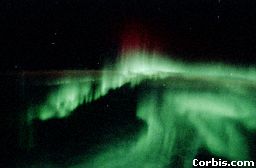 |
| a;fj |
| Aurora Borealis was, in essence, named after the Roman goddess Aurora, who ruled the dawn. Boreal is a Latin word, meaning "north." Hence, the Northern Lights. Needless to say, the Northern Lights have always been admired, revered, and even feared -- the subject of much folklore, superstition, inspiration, art, and the study of both scientific and religious communities, and philosophies that tend to contradict each other. The scientific causes and effects of the Northern Lights are involved and difficult to explain in lay-terms. The most brief and simple explanation is that they are caused by energy from the sun that interacts with Earth's magnetic field. If you imagine the Earth as a magnet, it has north and south poles, and this is a very simple way of explaining why Auroras are active in these areas of the world. |
| Works Cited and/or Consulted |
| Joe Brady. "Aurora borealis The Northern Lights." Copyright 1999, Virtual Finland. http://virtual.finland.fi/finfo/english/aurora_borealis.html [27 November 2001] Franck Pettersen. "Aurora Borealis - the northern lights." Way North. http://www.imv.uit.no/english/science/publicat/waynorth/wn1/contents.htm [10 September 1996] |
| For more information, visit the Links page. |
 |
| The Sun |
 |
| Aurora Borealis |
 |
| Aurora (as seen from space) |
| Aurora (from a shuttle) |
| There are so many stories that stem from the appearance of the Lights that they could never be counted. Many of these involve omens of impending doom, or the signs and promise of life after death. At one time, they were believed to mean that the end of the world was eminent. Some Inuit explained them with their belief that the mystical lights were torches lit by spirits in heaven, to light the path for newcomers. In |
| Europe, during the Middle Ages, the lights were said to be signs of dead soldiers, who gave their lives for their king and country and were rewarded with a battle in the sky. The mysterious lights have been an omen of illness, plague, death, and even war. Varying colors and patterns sometimes represented different things in different places. In northern Norway, people in awe of the light displays have greeted them with respect by walking carefully and being sure that the phenomena were not intimidated. This meant no waving, whistling, or any sudden or loud actions. In other places, it has been said that if you wave at Aurora Borealis, it will reach down and catch you. People say they have seen the Lights touch the ground, and heard them crackling as they danced. |
| Perhaps the most positive and glowing explanation of the Northern Lights, (and my personal favorite,) is that they are caused by Santa's magic as activity increases at the North Pole. Allow your imagination to present this image to you for just a minute, and you'll see that this story is just as plausible as any other. In fact, if magical activity at the North Pole coincides with the sun's activity, it could just be true, don't you think? Well, give it some thought, would you? |
